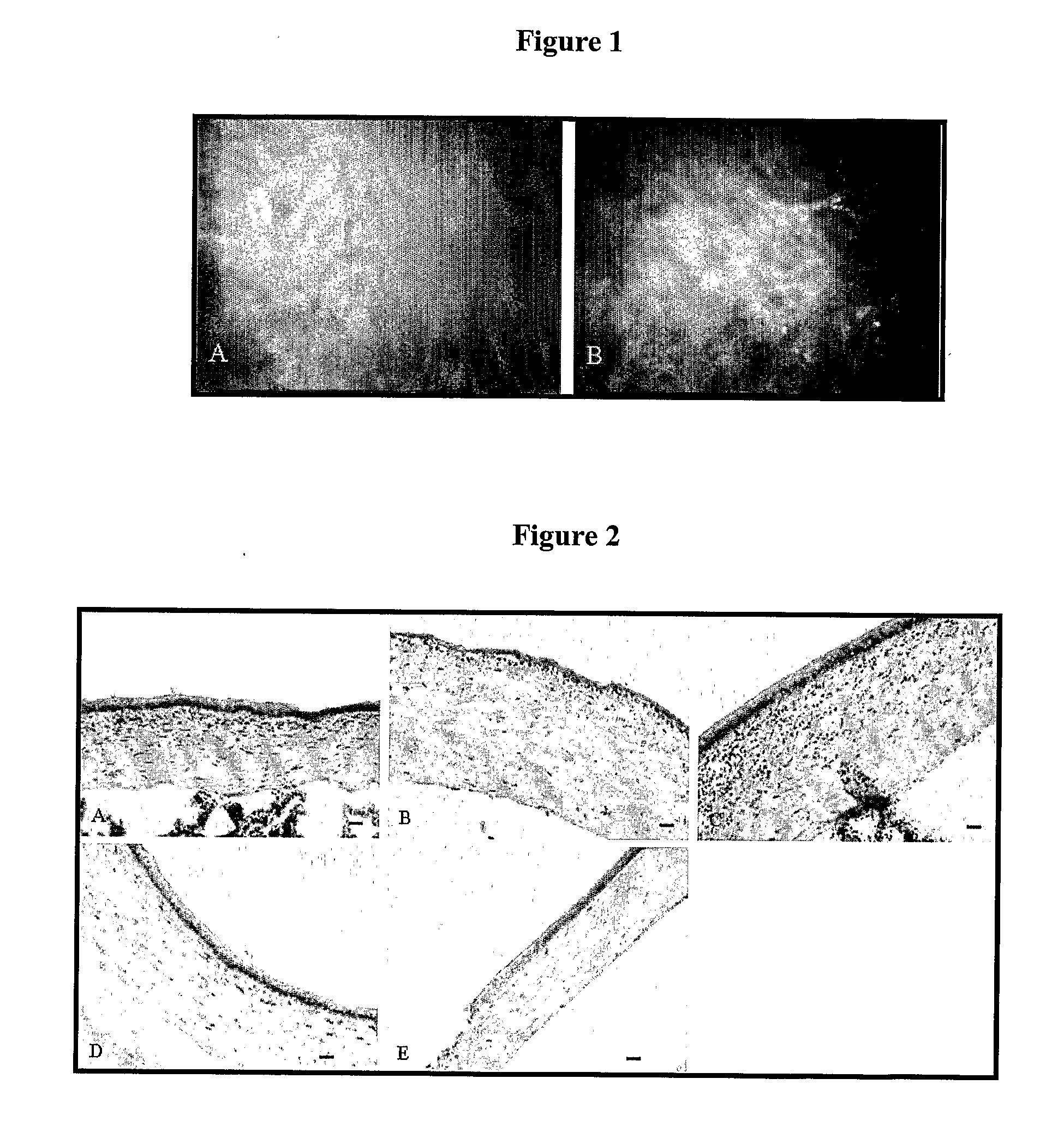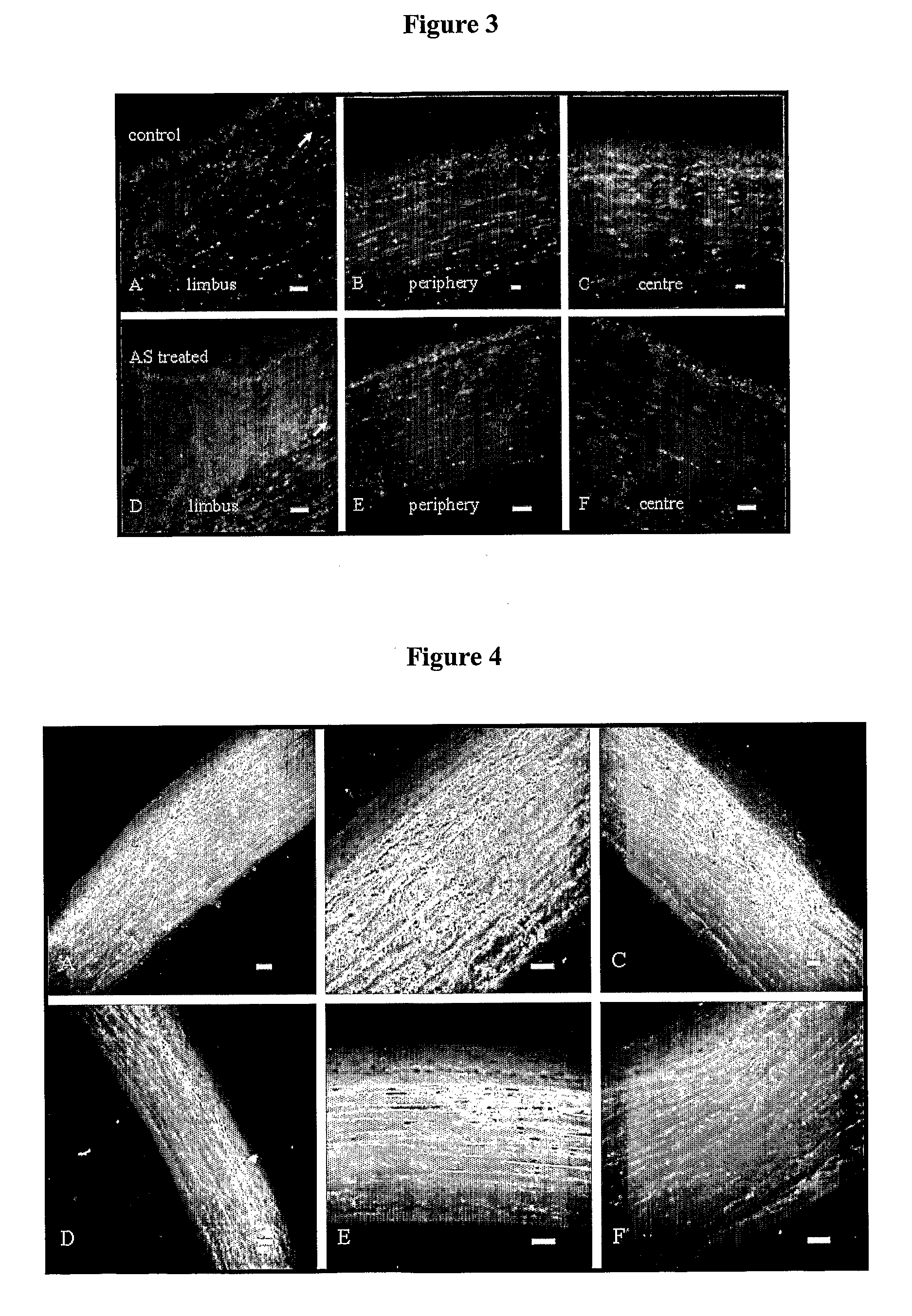Antisense Compounds Targeted to Connexins and Methods of Use Thereof
- Summary
- Abstract
- Description
- Claims
- Application Information
AI Technical Summary
Benefits of technology
Problems solved by technology
Method used
Image
Examples
example 1
In Vivo Analysis
Materials and Methods
Laser Treatment
[0191] Female Wistar rats (d32-34) were raised under conditions consistent with the ARVO Resolution on the Use of Animals in Research. Animals were anaesthetized by administrating a 1:1 mixture of Hypnorm™ (10 mg / ml, Jansen Pharmaceutica, Belgium) and Hypnovel® (5 mg / ml, Roche products Ltd, New Zealand) at a dose of 0.083 ml / 100 g body weight in the peritoneum of the animal.
[0192] Excimer laser treatment was performed through the intact epithelium using a Technolas 217 Z excimer laser (Bausch & Lomb Surgical, USA). The eye was centered at the middle of the pupil and ablation was performed with the following parameters: treatment area was of 2.5 mm diameter and of 70 μm depth. This resulted in the removal of a small thickness of the anterior stroma and of the whole epithelium. Excimer laser treatment was preferentially used to produce reproducible lesions and investigate the effects of connexin43 AS ODNs on corneal remodeling ...
example ii
Ex Vivo Analysis
Materials and Methods
Histology: Tissue Collection and Fixation
[0207] Appropriate numbers of animals (Wistar rats) were terminated at selected time points following photorefractive keratectomy and DB1 anti-connexin43 ODNs were administered to anaesthetized rats as described in experiment 1 above and corneal sections were prepared for histological analysis. Control rats had received laser surgery only. Whole eyes and control tissues were rinsed in Oxoid PBS prior to embedding in Tissue-Tek® OCT (Sakura Finetek, USA) and freezing in liquid nitrogen. When necessary (for the use of some antibodies), frozen tissues were later fixed in cold (−20° C.) acetone for 5 min after being cryocut.
Tissue Cutting
[0208] The procedure for cryosectionning was as follows: frozen blocks of unfixed tissue were removed from −80° C. storage and placed in the Leica CM 3050S cryostat for about 20 min to equilibrate to the same temperature as the cryostat (i.e. −20° C.). When equilibrati...
example iii
[0218] Corneas were placed into an ex vivo organ culture model and specific connexin modulated using antisense ODNs. Two connexins were targeted in these experiments, connexin43 and connexin31.1. Connexin43 downregulation is used to demonstrate that connexins can be regulated in vitro, and connexin31.1 was targeted because this connexin is expressed in the outer epithelial layers of the cornea in cells about to be shed from the cornea. The aim was to engineer a thickening of epithelial tissue by reducing connexin31.1 expression.
Materials and Methods
[0219] 30-34 day old Wistar rats were euthanized with Nembutal or carbon dioxide and whole rat eyes dissected. The ocular surface was dissected, disinfected with 0.1 mg / ml penicillin-streptomycin for 5 minutes and rinsed in sterile PBS. The whole eye was then transferred onto a sterile holder in a 60 mm culture dish with the cornea facing up. The eyes were mounted with the corneal epithelium exposed at the ai...
PUM
| Property | Measurement | Unit |
|---|---|---|
| Time | aaaaa | aaaaa |
| Length | aaaaa | aaaaa |
| Antisense | aaaaa | aaaaa |
Abstract
Description
Claims
Application Information
 Login to View More
Login to View More - R&D
- Intellectual Property
- Life Sciences
- Materials
- Tech Scout
- Unparalleled Data Quality
- Higher Quality Content
- 60% Fewer Hallucinations
Browse by: Latest US Patents, China's latest patents, Technical Efficacy Thesaurus, Application Domain, Technology Topic, Popular Technical Reports.
© 2025 PatSnap. All rights reserved.Legal|Privacy policy|Modern Slavery Act Transparency Statement|Sitemap|About US| Contact US: help@patsnap.com



